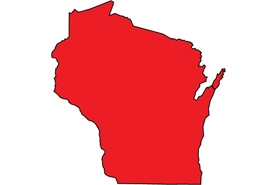Hawaii Arrowhead
(Sagittaria sagittifolia)
A very adaptable aquatic plant that can grow in a wide range of conditions, from fully submerged to dry soil. Cultivated as a source of edible tubers in some parts of the world, this Eurasian plant has proved a nuisance in many other countries, mainly when it grows in or near irrigation ditches. It is listed as a federal noxious weed.
Other names for this plant include:
- Common names: Chinese arrowhead, giant arrowhead, swamp-potato, old world arrowhead
- Scientific names: Sagittaria sagittifolia var. edulis; Sagittaria sagittifolia var. leucopetala; Sagittaria sinensis; Sagittaria trifolia; Sagittaria japonica
Classification in Wisconsin: Prohibited
- Ecological Threat
-
- This robust aquatic and wetland plant is related to our native arrowhead plants (Sagittaria latifolia, etc.). Still, it has become a pest in crop irrigation systems, drains and waterways around the globe.
- Hawaii arrowhead may rapidly overgrow fish ponds and influence reservoirs' oxygen regimes and environmental conditions. At the same time, its submerged vegetation can grow very thick, making access through the water complex.
- Identification
-
Leaves: This plant produces three types of leaves with longer ribbon-like green leaves growing under the water's surface, distinctive arrow-shaped leaves held above the water on triangular stalks and intermediate floating leaves.
Flowers: Hawaii arrowhead flowers have three petals and three outer sepals. The petals are large and white, with a purple blotch at their base. They grow on a distinct stem from the plant's root, with 2-10 whorls of 3 flowers.
Fruits & seeds: Round seed heads are produced with many flat seeds in winged sheaths. These seeds can float easily and travel great distances in moving water.
Roots: This plant produces stolons and rhizomes that spread in aquatic and wetland conditions, and the plant also produces tubers 2-5 cm long at the ends of root stems.
Stems: Are smooth and square or triangular-shaped.
Similar species: There is a range of native arrowhead species in Wisconsin, with the most common being broad-leaved arrowhead or Sagittaria latifolia. Broad-leaved arrowhead has broader leaves that are less sharply pointed than Hawaii arrowhead. Most native arrowheads lack the purple blotch located at the base of the flower petals except Sagittaria montevidensis, but this also has a "D" shaped cross-section to the stem as opposed to Hawaii arrowheads, which tends to have triangular-shaped cross-sections.
- Distribution
-
Currently, there have been no reports of Hawaii arrowheads in Wisconsin. Have you seen it? Please send us a report.
- Control
-
Mechanical: Where there is a small or newly established population, the plant may be removed by digging out all parts of the plant, including rhizomes and tubers.
Chemical: Aquatic-approved herbicides require a permit.
- Resources
- Sources for content:
- APHIS pest risk assessment for Sagittaria sagittifolia [exit DNR].
- Invasive Species Specialist Groups: Global Invasive Species Database


